EPISTEMIC BUGS AT WORLDMAKING
Exposing ecotones of media practices
“[E]ven in science the object of research is no longer nature itself, but man’s investigation of nature.” -Werner Heisenberg[1]

The Radical Other and the entomologist Jaakko Kullberg
Most of the time, insects escape us. Flying insects are hard to see. The winged beings are small; they move quickly, and often they do not leave any traces. We tend to pay attention to the bugs only when they harm us. Elsewise we avoid contact with the potentially stinging and biting critters and seek to get rid of the nuisance as soon as possible. Despite their size, the tiny creatures can evoke powerful emotional reactions in humans. The sheer presence of an invertebrate body is likely to trigger culturally determined feelings of fear and disgust. We relate to insects with a strange mixture of allure and repulsion which is hard to explain in rational terms.[2] A deep sense of otherness aroused by the weird anatomy and strange behaviour of exoskeletons[3] challenges our love for nature. It is a truly perplexing thought exercise to try and empathize with a spineless creature lacking lungs, veins and arteries but equipped with six legs, four wings, antennae and an eye on its penis (the swallowtail butterfly). Or to imagine having taste buds on one’s feet (common for all flies). Not to mention a butterfly species with an ear in its mouth.[4]
Recent scientific testimonies have shown alarming declines in the number of pollinators[5] and insect biomass[6]. The trend has raised growing public awareness of the necessity of insects for maintaining functioning ecosystems and biodiversity. Our lives depend on the services provided by arthropods and wild insect populations. To survive we need to acknowledge that we rely on insects not only for pollination, but for decomposition and soil formation as well. A fact that encourages us to overcome innate entomophobic[7] aversions and calls for more tolerance towards alien ways of being. Insects constitute a vital part of nature’s infrastructure, and they deserve to be regarded with respect and curiosity.
What’s out there?

Biology aims at a systematic mapping of the natural world. But humans can only get a fraction of nature’s bewildering complexity; the rest remains subject to speculation through deduction, fiction and imagination. Epistemically bugs compare to sea or stars. The sheer number of different insect species[8], myriads of them probably still unknown to science, surpasses our capacity to taxonomic governance and challenges established anthropocentric paradigms for mastering the universe. The compelling insect question invites us to rethink the methods applied in the acquisition of empiric knowledge and imposes us to face the limits of our understanding. Insects constitute an epitome of how little we know of the world we inhabit; even within our closest and most familiar surroundings we are likely to share air, water and ground with animal neighbours we have no clue of.
Drawing from the scientific study of insects, my project Insects among Us sets out to fathom insects’ ephemeral existence. Moving away from biological research, I look at insects from a media ecological perspective. To quote from the media theorist John Durham Peters’ pragmatic philosophy of elemental media[9], I believe that “expression and existence merge”[10] in phenomenotechnical[11] imaging practices encapsulated by natural science. In Peter’s view, the human lifeworld is articulated and mediated through cultural artifacts created in interplay between material environment and human technologies that derive from bodily organs. The species-specific habitat underpins our epistemic and cognitive predispositions as well.
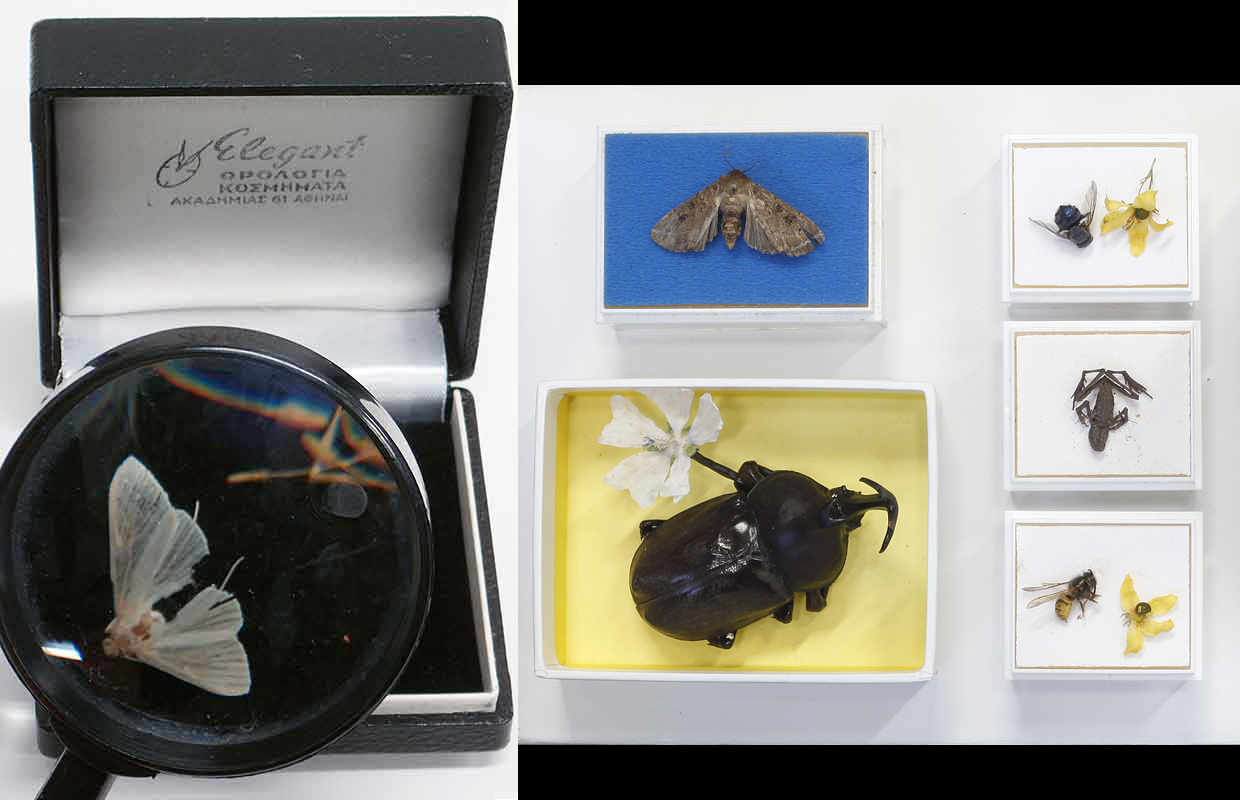
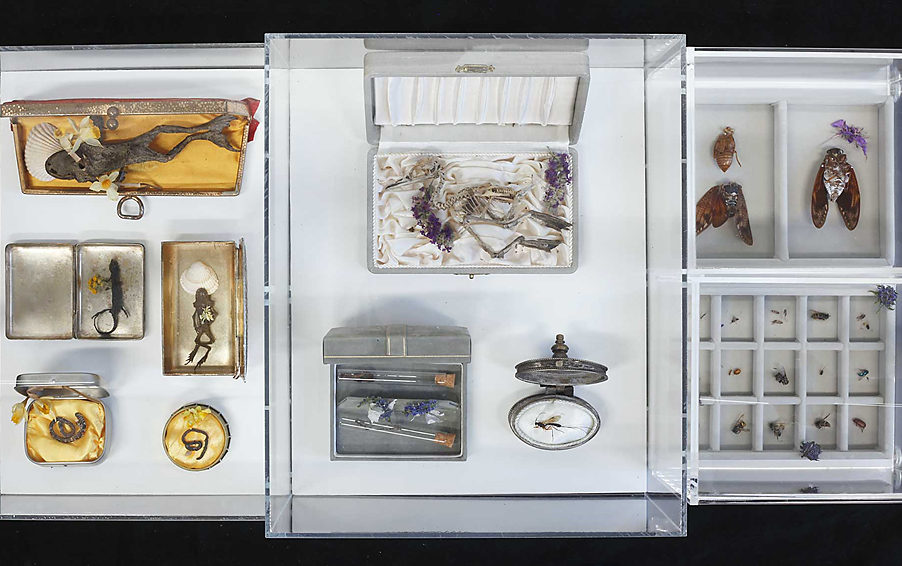
Media environments in action
The eerie world of insects evokes ontological problems addressed by philosophy, art and science. Following Marshall McLuhan, Peters argues that “(m)edia are … crafters of existence”. Media shape “our infrastructures of being, the habitats and materials through which we act and are. This gives them ecological, ethical, and existential import.”[12] Embracing thinkers of cultural techniques and technicity such as Peters, McLuhan, Uexküll, Leroi-Gourhan, Heidegger, Bachelard, Simondon, Latour and many others, I regard instrumental practices of science and art as modes of philosophical reflection similar to a craft. Hands-on experimental devices designed for capturing the fleeting and the recalcitrant enable us to reveal phenomena that ultimately defy materialisation. For example, active and passive methods of entomology ranging from fieldwork to preservation practices touch upon deeply entangled ontological questions of presence and absence, sign and symbol, actants and agency. A deeper look into the techniques implemented in collecting, mounting, preservation, identification and curation of species may reveal the scale and scope of epistemic affordances that define the limits of human knowledge.

In Insect Media [13], Jussi Parikka looks at insects in the contextual framework of digital media. Focusing on insect biology and social action, he develops a nonhuman media theory which challenges the traditional anthropocentric view through animal technologies such as networks, swarming and intelligent agents. Unlike Parikka, I adopt a perhaps less radical posthumanist stance. Instead of the very insects and their behaviour, my focus is on our relation to insects.
Insect among Us draws from natural history and stresses the techniques of worldmaking that facilitate, translate, mediate and manifest the world of insects to human eyes and ears. As exemplified by various material engagements with insects, my project endeavours to reveal the epistemic affordances underlying the human point of view and to widen our perspective through art works that elaborate on visual and acoustic mediations embedded in entomological practices. However, in so doing I do not intend to subordinate insects to an instrumental role in service for human needs or benefit. Quite the contrary; exposing the conditions that underpin the airborne bubble of the insect world, my study aims at revealing anthropocentric premises within the human (cultural and biological) cognitive bubble.
Uexküll adopted the bubble metaphor to describe natural species-specific life worlds as unique media environments tuned to trigger biologically determined responses in the sensoriums of animal, plant or human species.[14] Following Uexküll, Peters proposes to “regard media as enabling environments that provide habitats for diverse forms of life”. “Hostile environments breed art”, Peters argues.[15] With that he refers to the inspiring challenges encountered by humans in our desperate attempt to appropriate elements foreign to the earthbound mammals that we are. Innovations such as ships, aircrafts, telegraph or similar literally ground-breaking media technological apparatuses were destined to transcend the boundaries of our terrestrial habitat; they emerged from a need to expand towards the sea or the air. According to Peters one medium enables the other like a vessel that reveals the sea as a medium to navigate in.[16] The same goes for instrumental practices applied to the scientific study of insects. Difficulties in observing the delicate flying beings can be overcome with devices that unfurl the contingencies of the ethereal medium and open up perspectives onto the hidden life worlds inhabited by airborne creatures.
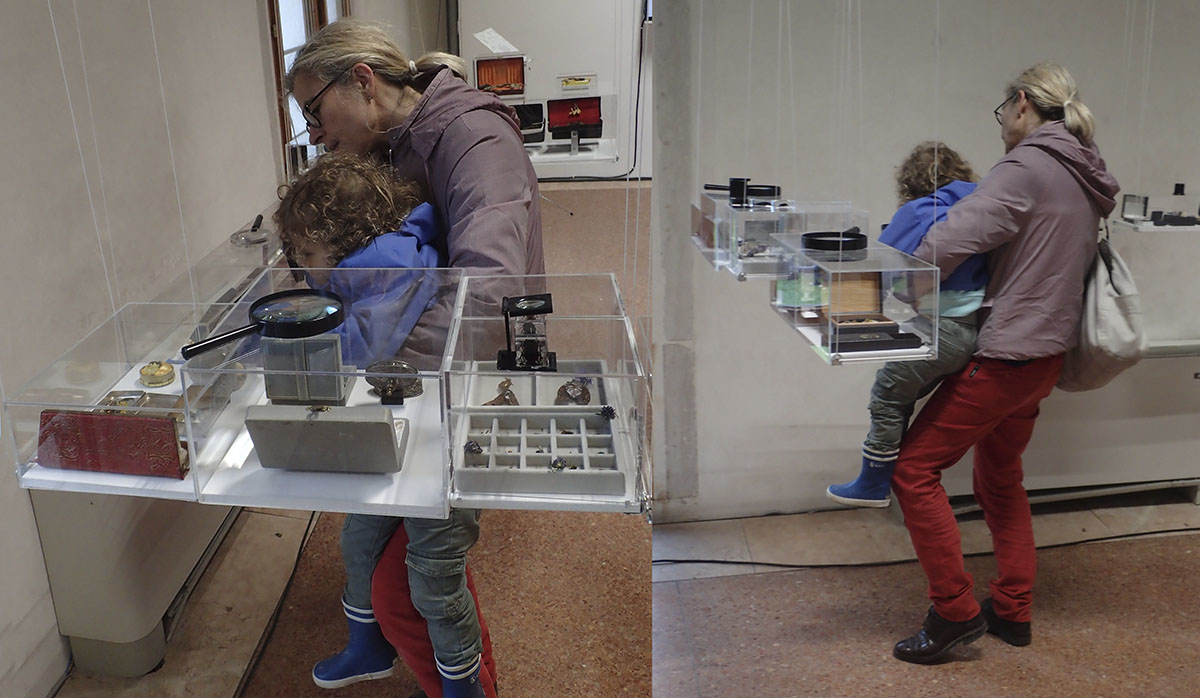
Entomological Encounters – case studies in worldmaking
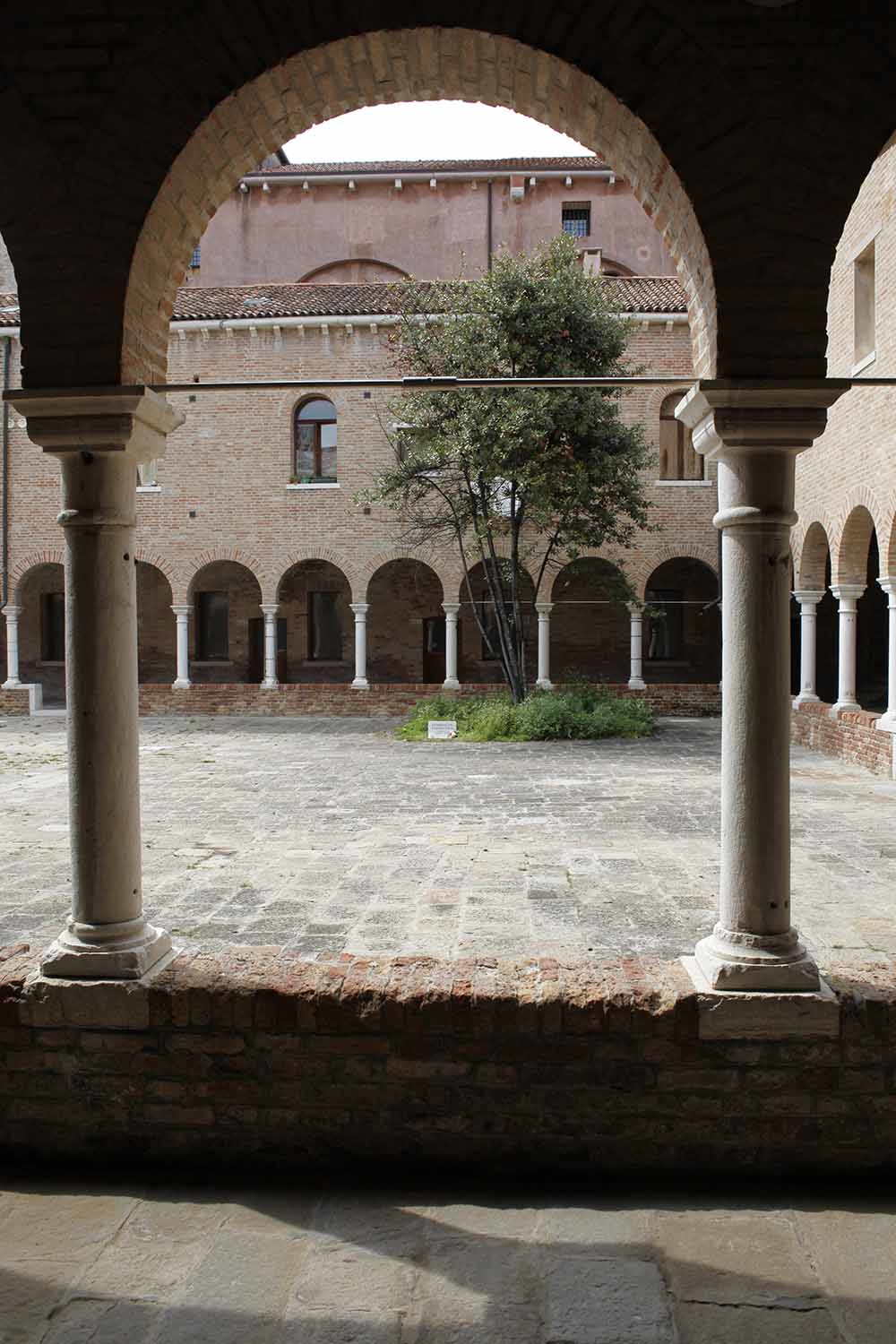
At the Research Pavilion 2019 venue on Giudecca Island in Venice, a series of works titled Entomological Encounters constituted an insect observatory for empathic looking and listening. Indoor and outdoor spaces of the former convent of SS. Cosmas and Damian housed small-scale site-specific installations that turned to examining the eerie life worlds of insects. The works made use of the spatial characteristics of the Sala del Camino exhibition hall and the cloister.
Inside Sala del Camino my installations were mounted to hover in the air; the showcases and containers were set to levitate at human eye level supported by thin lines hanging from the high ceiling trusses. The only exception to the otherwise airborne exhibition was the Memorial to an Earth Worm, a tombstone which literally touched the earth. A modest stone slab to honour the work of earthworms was erected under a small tree on the only green spot flanked by the cloister arcades. The insect condition was mediated and exposed through a series of experiential visual and audio pieces derived from methods of entomological research. The installation Nature Morte (Natural Causes of Death elaborated on entomological preservation and specimen curation techniques such as setting pointing pinning and spreading, Diaries of a Serial Killer and The Malaise Trap reflected upon fieldwork practices including trapping, mapping and collecting. And last but not the least, an audio installation entitled Wing Beats revisited the heuristic acoustic method for identifying insect species devised by the Finnish entomologist Olavi Sotavalta in the 1940s.[17]
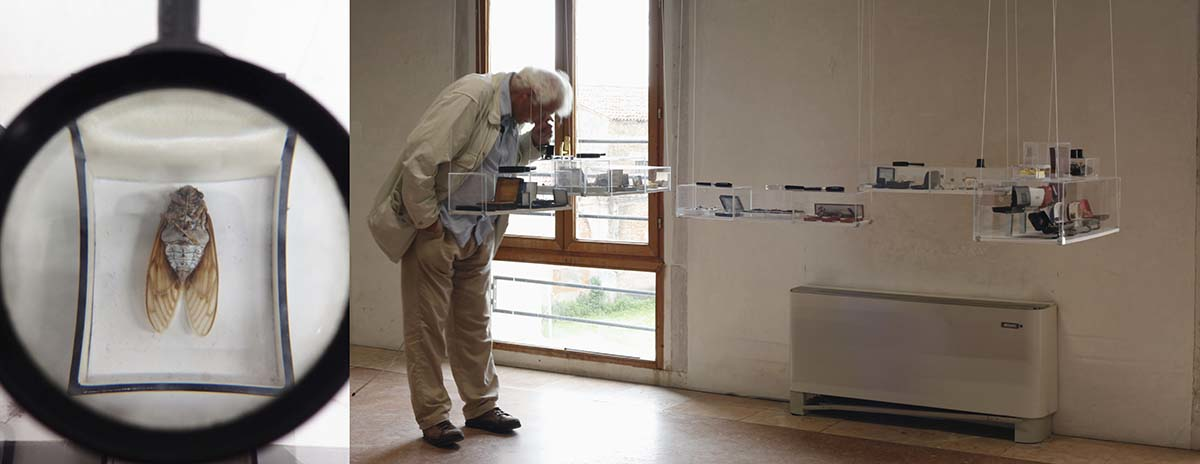
The scientific study of insects is a prime example of a discipline characterised by a plethora of pragmatic techniques for capturing the fleeting and evanescent. As evidenced by Robert Hooke’s Micrographia, Jan Swammerdam’s demonstrations[18] or Antoni van Leeuwenhoek’s ingenuous microscopes, what started as an enquiry into the tiniest of beings stimulated major technological progress on the field of applied optics. The substantial development of lens-based devices again contributed to profound changes in our worldview. Rendering ephemeral phenomena visible to the naked eye had a huge ontological impact. Along with new perspectives, it paradoxically offered a means for escaping ourselves. Instrumental practices let us break away from the confines of our sensorium and enabled us to look at the world from the outside. Scientific instruments created a mirror which allows transcending the human Umwelt bubble.

Fine art and natural science are both equally concerned by visual methods of enquiry such as observation, inscription and rendering. The natural world is continuously changing; the study of the real calls for interaction, dialogue and imagination. Phenomena emerge within the physical and material processes of observation, measurement and recording, only to fall again outside the scope of human cognition. Techniques of tracing down, registering, collecting or inscribing constitute ways of worldmaking. Heidegger stresses the poetic and creative aspects of this strictly human engagement.[19] To create a coherent world through language or visual articulations entails continuous re-shaping; we are in an ongoing process of “re-discover[ing] by new enquiry”[20]. Linguistic and pictorial explorations are endorsed by the cultural capital accumulated in the legacies of visual cultures and vocabularies of existing human languages. Moving away from Heidegger’s fundamental ontology, Nelson Goodman stresses the practical aspects of medial engagement. Goodman’s world of becoming emerges from cultural recycling; it entails tinkering with existing textual discourses as well material heritage on hand.[21]
Craft like aspects are prominent in both art and science, but the disciplines differ in ways of acting and reflecting upon the data acquired through fieldwork and studio practices. Highlighting the poetics of worldmaking, Insects among Us explores the similarities and differences between the approaches of visual art and natural science.

In absence of insects – showcasing the means of study
Few years back car drivers worldwide started to notice a decline in the number of bugs smashed against the windshield. News press was alerted, and scientists brought to light an impending eco crisis caused by vanishing insect species. The so-called windshield (or windscreen) phenomenon[22] is a case in point revealing the impact of media coverage. A latent key piece of infrastructure becomes apparent only when it is echoed and framed as a relevant topic of discourse. Prompted by mass media, we started to fathom insects’ extinction. Or to cite another classic example; in 1962 Rachel Carson’s literary blockbuster Silent Spring[23] was a whistle-blower that explored the aftermath of DDT and other synthetic pesticides. The book brought to light the catastrophic consequences of sloppy handling, wild spraying and reckless marketing of the deadly chemicals. Carson’s prose made absence tangible; her persuasive rhetoric succeeded in vividly evoking the dystopia of a quiet earth without birdsong.
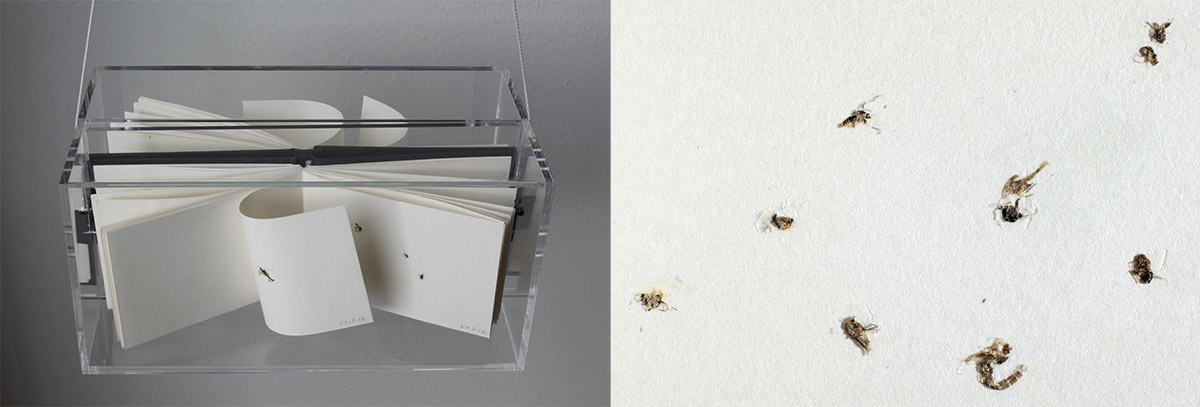
Interplay between physical absence and medial presence is the key to understanding my enterprise with insects. Absence of the de facto object of study is a common denominator for every single piece of work in the Entomological Encounters -series. Insects and arthropods are present only by proxy, through intermediaries such as funeral arrangements, artefacts and scientific instruments, recorded soundtracks or (photo)graphic traces.
Paradoxically, the means of study created a distance which in turn constituted a prerequisite for the visibility of the object under scrutiny. Exhibiting absence was both a strategic tool and a framing device; insects were externalized, indicated and conditioned by way of different media.[24] In the following few paragraphs I will look closer at the dynamics of revelation and effacement embedded in the material and instrumental setup of the installations.

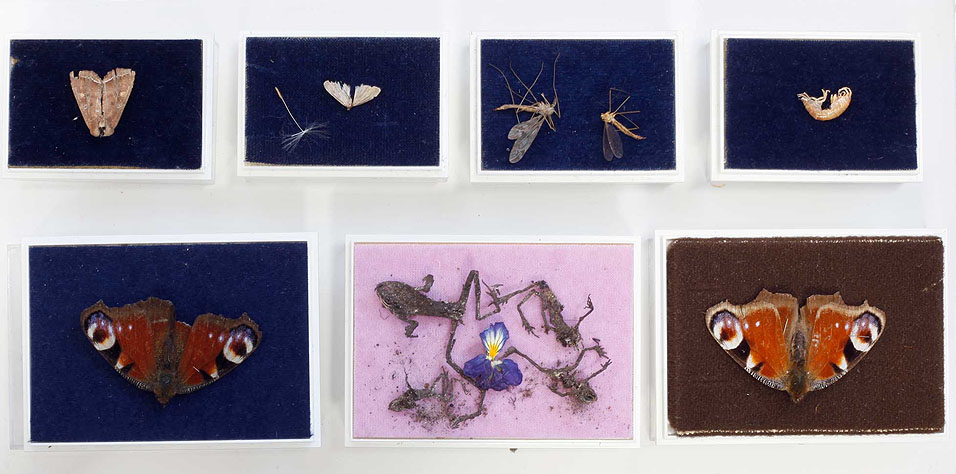
It is rare to find dead insects in nature; usually the insect leftovers, if there are any, vanish rapidly in the food chain. The Nature Morte (Natural Causes of Death) exhibits a broken chain where the tiny cadavers are exposed embalmed by a mortician and placed on silk and satin in lavishly furnished coffins. The small caskets are made of former jewellery boxes, eyeglass cases and packages of branded luxury items. Bouquets of dried flowers highlight the beauty and fragility of insects. Details of the funeral assemblages can be inspected with magnifying glasses provided on the showcase vitrines.

Playing with cultures of death, the Nature Morte -installation celebrates the lens and the act of looking. In my mind it resonates well with Svetlana Alpers’ findings in her seminal book The Art of Describing. Like the famous still lifes of the 17th century Dutch masters, my work offers “delights to the eye” and plays with “the craft of representation”[25] . Alpers’ enquiry sets out to establish links between “finding and making”[26] .“The age of observation”[27] gave rise to an epistemic turn that “treat[ed] knowledge as visible and possessable”[28] and emphasised the relevance of the visual over the textual[29]. The Dutch painters, draftsmen and artisans introduced a new visual capital which exposed the audience to aesthetic cultures characterized by close empirical investigation and detailed visual records of the material world. Alpers discusses the causes and effects underpinning the proliferation of lens based visual practices ranging from surveying, mapping and collecting to works of fine art. Optical innovations “deanthromorphized vision”[30], as Alpers tellingly intimates. The instruments relativized the actual size of objects, fragmented the scene and distanced the observer through a detachment of the eye from the viewer’s body[31]. Drawing from Kepler’s experiences in astronomical observations, Alpers concludes that in order to know the world, “we need to understand the instrument with which we view it, […] with distortions and errors built in”[32], a statement that applies to the very human eye as well.
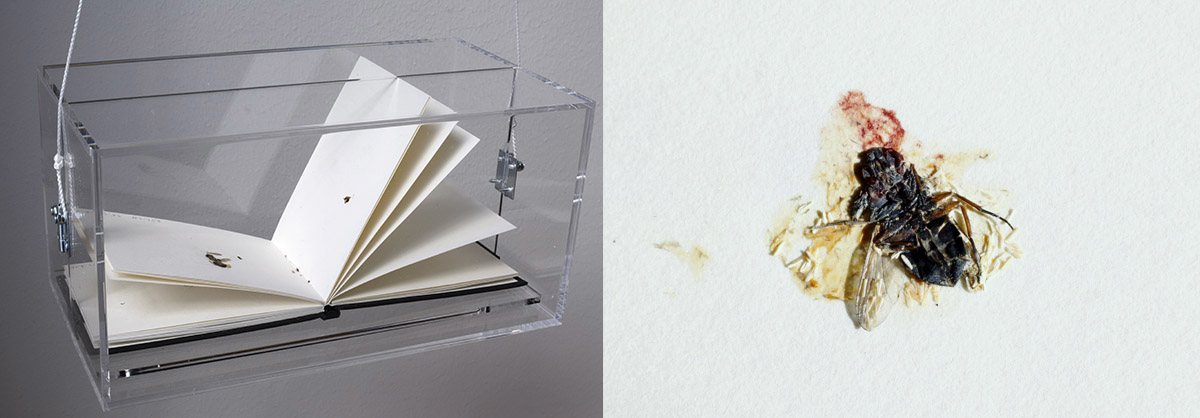
The themes of absence and death are further explored in the installations Diaries of a Serial Killer and Memorial to an Earth Worm. Like the windshield phenomenon, the Diaries of a Serial Killer made insects’ death toll visible. Everybody kills insects occasionally, especially when the bugs happen to enter the house. The swatting happens automatically and goes unnoticed. Some years ago, I started using artists’ sketch books to eliminate unwanted intruders. By and by, my swatter pads amounted to a miniature splatter and gore archive. Page after page smeared with insect blood[33] and intestines witness of the surprising brutality inherent in the seemingly harmless and innocent quotidian acts. The books are presented with pages curled and leaves spread out so that the binders resemble winged beings at flight. In Venice, the installation included elements of crowdsourcing. The audience was provided with a few empty sketch books placed on the windowsills of the exhibition hall. Attached to the books was a little note in both English and Italian urging the spectator to kindly contribute to the swatting. The note said; “The serial killer would be thrilled to see her work continue in Venice. Feel free to use the sketch books as swatters. Please indicate the date of the catch”.
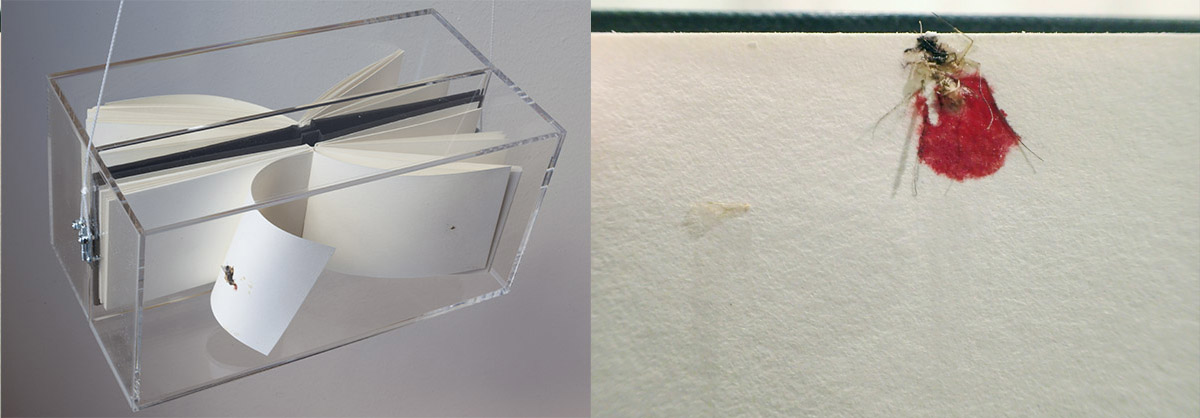

John Peters intimates that tombs and graves probably count among the oldest recording media in human history. Other animals mourn the deceased as well, but they do not erect monuments for their loved ones, nor do they mark graves with inscriptions. Peters looks at the burial of the dead from a species-specific media ecological perspective. He considers lasting gravesites as conceptual prototypes for all systems of symbolic storage. The grave is civilization’s ultimate semiotic “device”; it conveys a durable form that allows humans to overcome death through medial presence.[34] At the RP#3, the cloister of the convent housed a gravestone in white Carrara marble (30x50x3cm) engraved with the inscription Lumbricus Terrestris.
The Memorial to an Earth Worm pays homage to an underappreciated underground object – the common earth worm. The hard work of the worms is a precondition for life; they take care of the soil that feeds us. Dirt as a fertile habitat and live medium became apparent during the summer exhibition. The Latin name of the earthworm along with the opening and closing dates (*8.5. and + 31.8.2019) were carved on the stone as of the dates of birth and death of the poor vermin. Just before the opening party in the beginning of May, the immediate surroundings of the gravesite were cleared of vegetation, and a bouquet of artificial flowers (made of silk and plastic) was placed on the stone. During the following summer months, real plants regained control of the gravesite, and the stone was gradually overgrown with greenery. End August, nature had already taken over culture; the monument and the bouquet were both entirely covered by weeds that hid the funeral stone from view. In the end, there is no escape from going under. As my late mother used to say: “Worm’s mouth is the last door to open”[35]. Spot on and good to keep in mind.
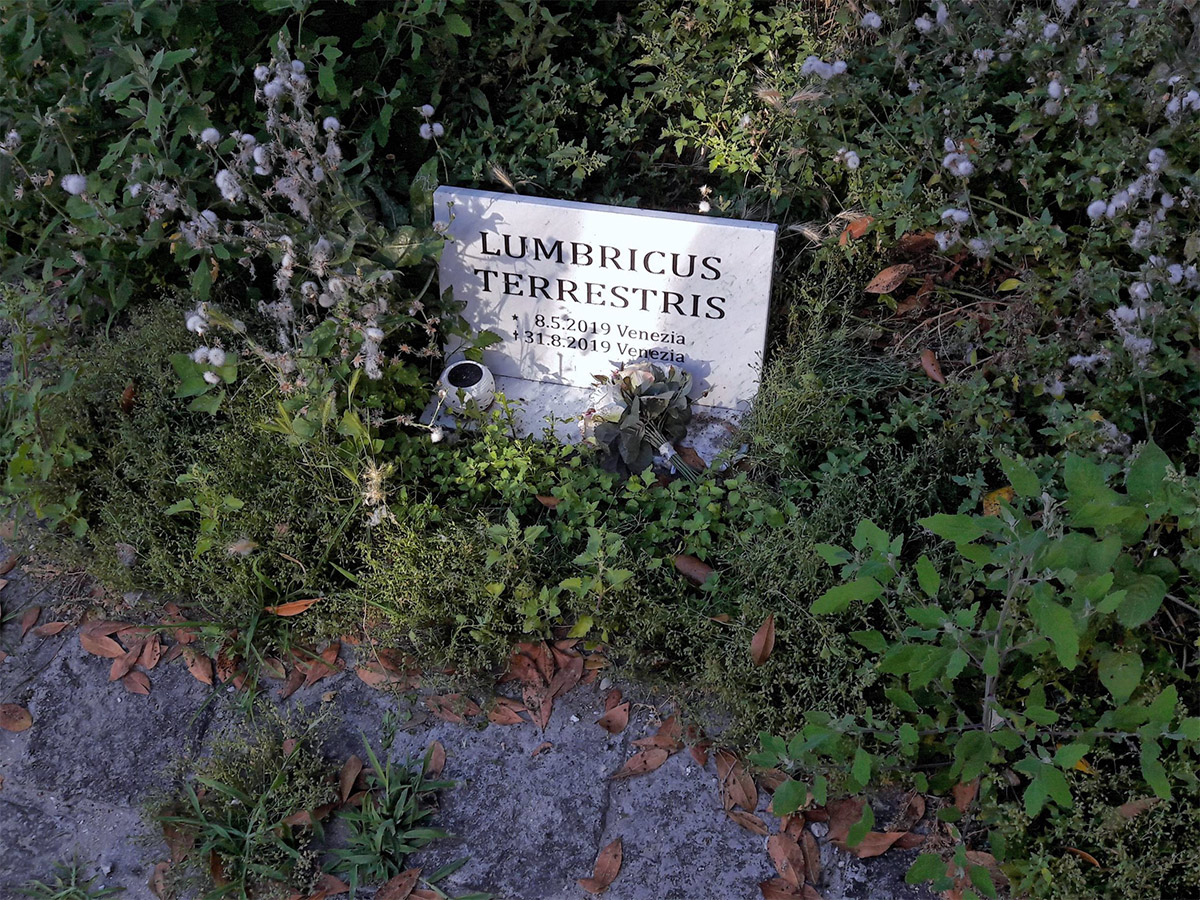
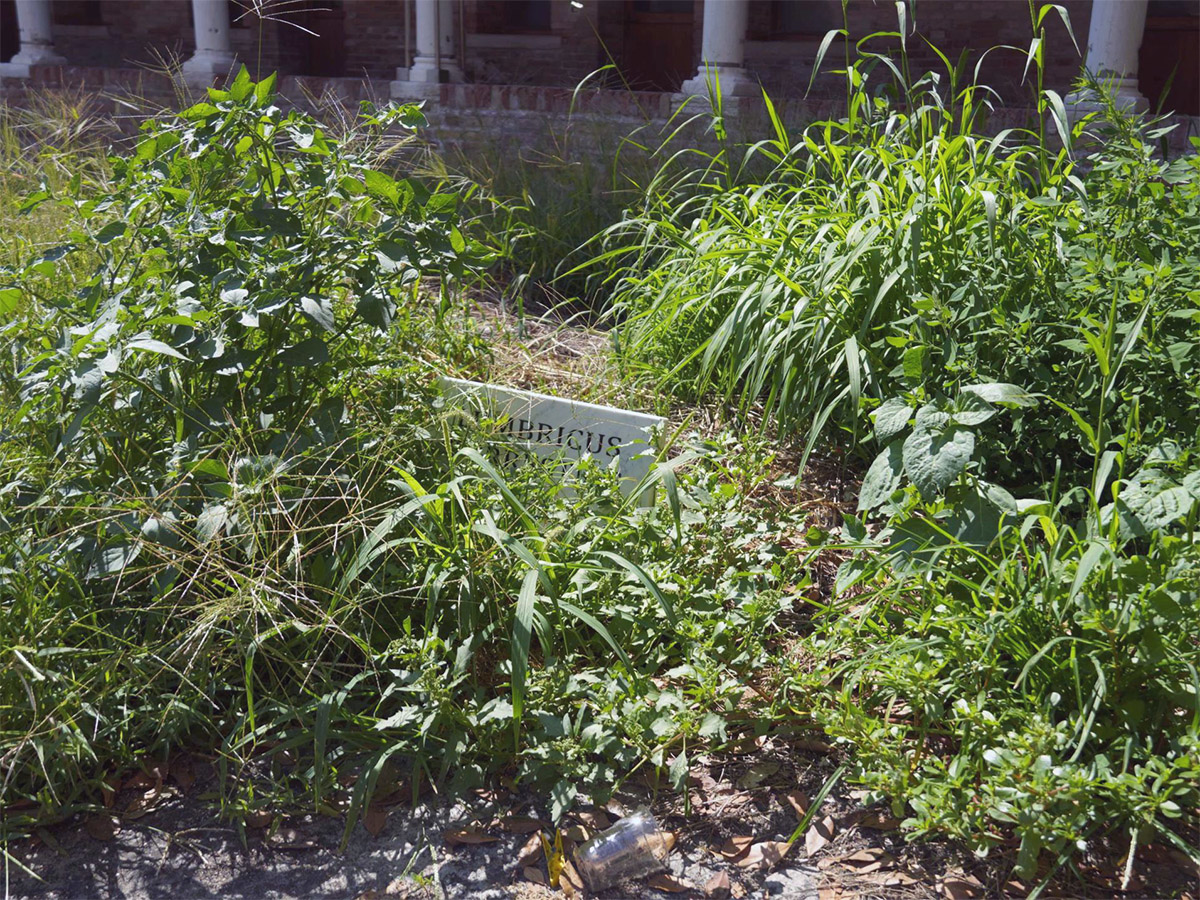
Memorial to an Earth Worm in June and August. Photographs: Maiju Loukola (left) and Mika Elo (right)
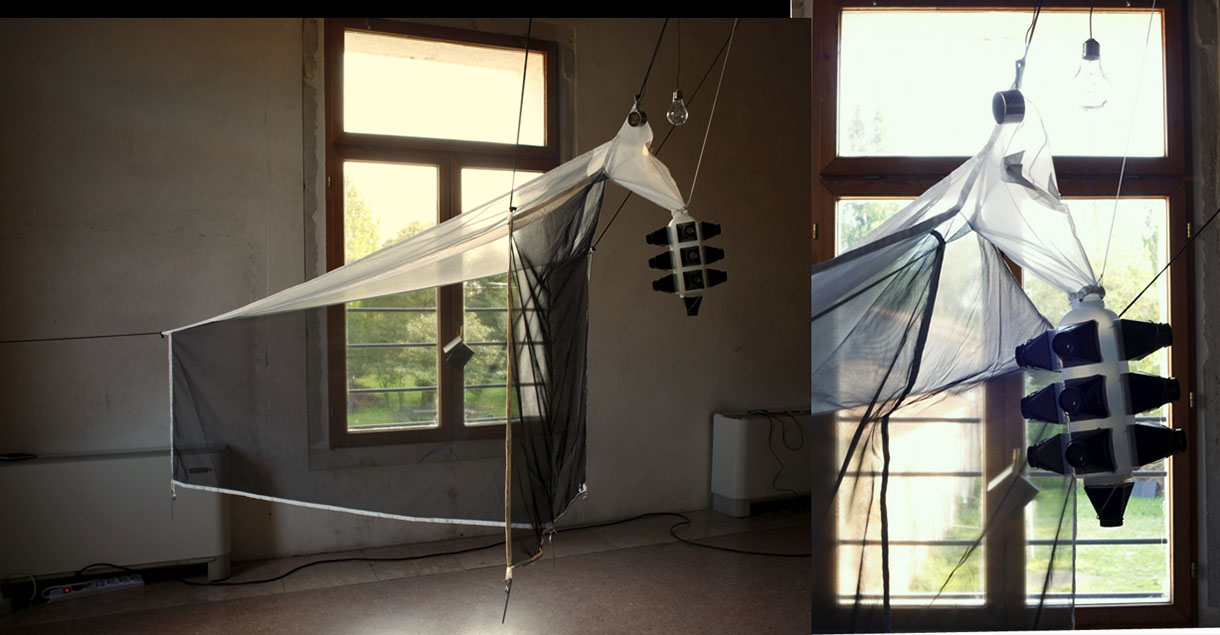
Both the Malaise Trap and the WingBeats derive from heuristic methods devised by two Nordic entomologists. “Malaise traps” are used for harvesting insects through passive collecting. The tent-like structure was invented by the Swedish René Malaise in the 1930s. The trap relies on the interception of flight; the fabric funnels passing insects towards light, and the bugs end up in a translucent collecting vessel attached to the tip of the tented cloth. The initial idea for the trap emerged from Malaise’s observations on a fieldtrip to Far East; insects that happened to enter a tent, could no longer escape through the door opening. However, if the tent’s roof fabric was punctured, the imprisoned insects used the holes to exit towards light. Based on this behaviour pattern, Malaise developed an inventive design that enabled him to capture large amounts of exotic species previously unknown to science.[36] In the novel Flytrap[37], the amateur entomologist and professional (play)writer Fredrik Sjöberg recounts the story of the malaise trap and elaborates on his personal experiences from using the device. Sjöberg evokes the unselective and “industrial” quality of the trap. Since it captures any flying creature attracted to light, the trap is a genuine mass murderer. On the other hand, Malaise’s method is the only way to locally detect, monitor and identify passing insects. The simple trap allows a comprehensive inventory of the diversity of species, including bugs whose existence nobody had been aware of. It is still a current method used in biodiversity studies that target rapidly changing habitats such as urban ecosystems[38] or areas affected by climate change. My installation transforms Malaise’s design into a collective viewing device. Instead of a collecting jar, the tip of the tent is equipped with a set of slide viewers that include photographs of insect bites. In my mind, the semiosis of the swollen red marks on skin equals to animal footprints. Both express the ontological question: who was out there (after me) when I was not paying attention?

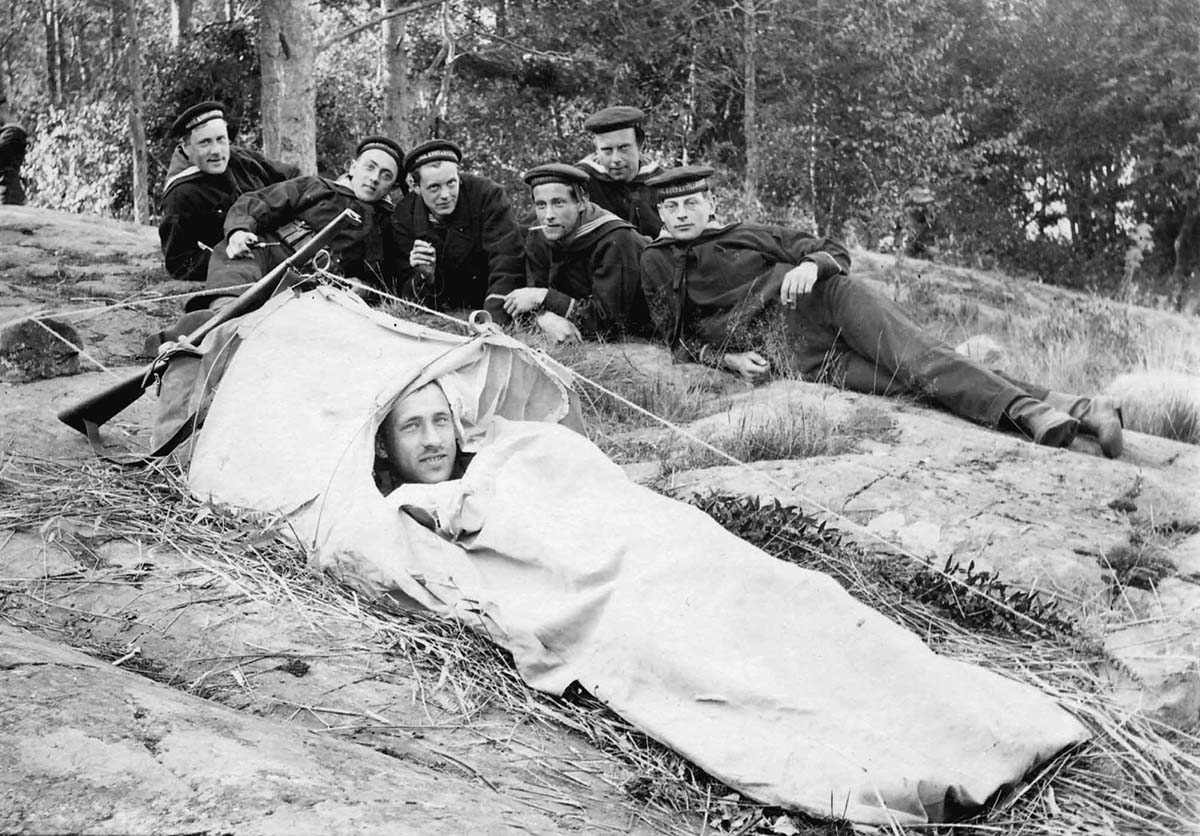
René Malaise in his one-man-tent/sleeping bag invention while doing his military service in Vaxholm in 1914. Photographer unknown[39]

Like the Malaise trap, my Wing Beats installation is a tribute to the work of an entomologist. Published in a 1952 paper in Nature, the Finnish Olavi Sotavalta presented his “ears-on” idea of an auditory approach for identifying insect species. Sotavalta was an amateur musician endowed with absolute pitch. Sotavalta’s sensitive ear allowed him to pick up the exact pitch of insects’ buzz and to translate the wing stroke frequency into the tonal register of instrumental music. Flying insects are difficult to recognise visually; e.g. subspecies of mosquitoes or hover flies may look very similar, but they differ in flight-tone, as Sotavalta called the buzz peculiar to certain species[40]. As a result of his investigations, Sotavalta was able to map out a comprehensive tonal scale of flying insects occurring in southern Finland[41]. Sotavalta’s doctoral thesis includes an appendix with a systematic list of over 200 flight-tone determinations, most of them made at his summer cottage between 1939 and 1946, a turbulent period of repeated warfare between Finland and Russia. After reading Sotavalta’s story, I was haunted by the image of a solitary entomologist, who who tried to evade the rumble and roar of tanks and airplanes and retreated to the silence of his cottage to listen to the quiet buzz produced by insect wings.[42]
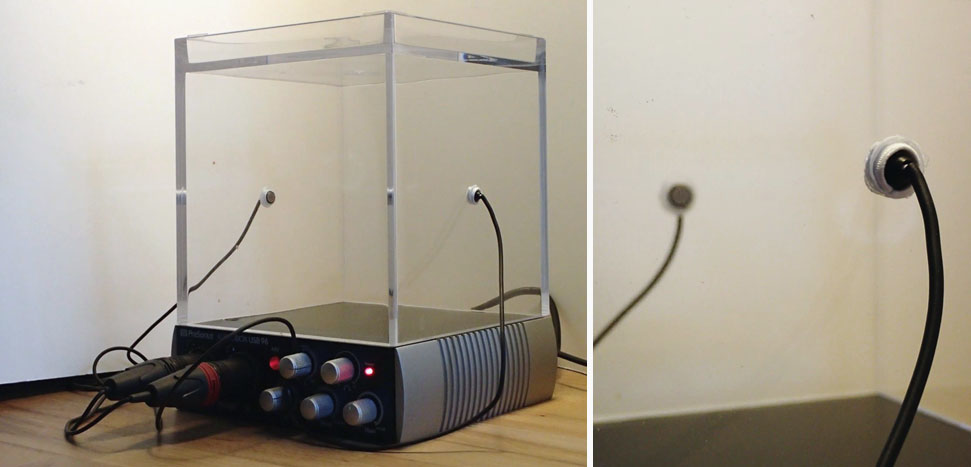
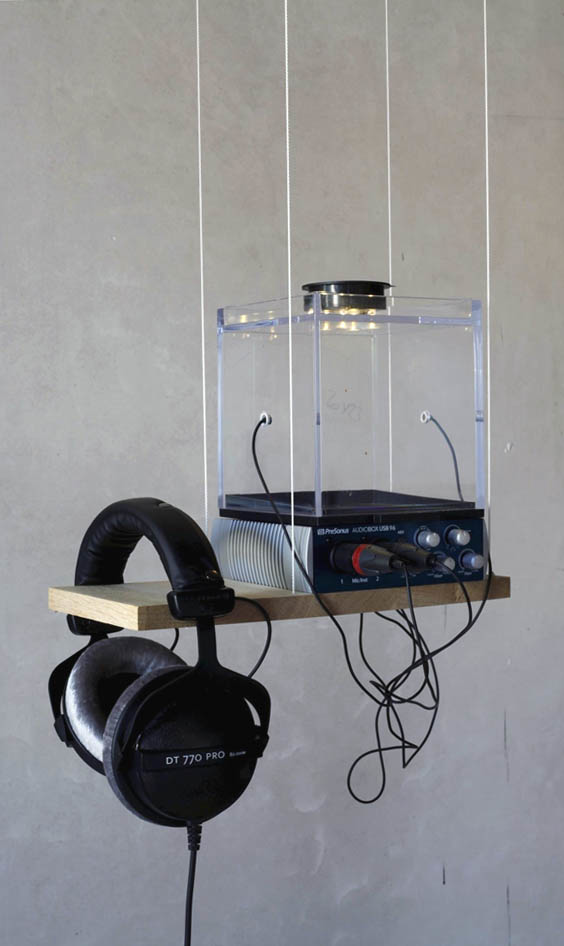
The installation shows a miniature “recording studio”, also called as the Karaoke Booth. The box is made of an empty acrylic display case (14x14x14 cm) placed on a sound card that serves as a pedestal and floor for the cubic studio. A pair of miniature stereo microphones facing against each other were drilled on opposite sides of the booth. During the summer 2018, I made live audio recordings of flying insects imprisoned inside the box. The noises produced by insects’ wings and footsteps were edited and (re)composed by the sound artist Tytti Arola into ten swinging Wing Beats. At the exhibition, the three- to five-minute-long pieces were looped and played back through headphones while the spectator/listener was presented with an empty Karaoke Booth to look at. Thinking back to Olavi Sotavalta’s love for music, I believe that Arola’s Wing Beats -variations pay a beautiful tribute to his keen interest in the subtle murmur produced by insects’ wings.
The size of the booth equals the average diameter of human head, with ears approximately 15 cm apart from each other. Occasionally, the physical dimensions of the recording studio echo binaural acoustic phenomena. When played back through headphones, every now and then the sound starts to “circle” between the ears as if an insect was buzzing inside one’s head. The phenomenon is product of a reversed binaural effect derived from the miniature studio’s anthropomorphic layout with small microphones directed towards each other. Another media archaeological anecdote relevant for my installation concerns the technology of early microphones. In Gramophone, Film, Typewriter Friedrich Kittler infers that the sensitivity of David Edward Hughes’ first carbon microphone from 1878 was tested with a fly whose footsteps it amplified and recorded faithfully.[43] Like Hughes’ surprised contemporaries, I was struck by the loudness of the rhythmic thumping produced by six tiny feet hitting the acrylic case.

Let's BUZZ again, like we did last summer:
The habitat of artistic research as an ecotone of interconnecting practices
The night after the opening party, Tytti and I launched a performative Insect Karaoke Happening at the Research Pavilion venue. The Wing Beats soundtrack was played back through loudspeakers, and the audience was given simple DIY instruments (thin wine glasses and contact microphones) to join in making music with the electronic insect band. The glasses were played manually by rubbing glass rims with fingers whereas the contact mics were connected to Tytti’s soundcard which manipulated the noises with added effects such as echoes or delays.
For me, the half an hour-long playful session was the culmination of the whole research project. Among the audience were researchers from other RP#3cells such as musicians from Otso Lähdeoja’s ECM band playing their own broken instruments or Esa Kirkkopelto rattling with his homemade tambourines. Breaking away from the confines of verbal discussions in academic seminars, we proposed collaborative research practices and sharing through incorporeal modes of engagement that celebrate informal events and collective assemblages of enunciation.
In my mind, the notion of ecotone could come in handy for discussing certain key idiosyncrasies particular to the environment of artistic research. Derived from biology, an ecotone refers to a transitional area at the boundary of adjacent habitats or neighbouring ecosystems. The word is coined from the Greek tonos (tension) meaning a place where two ecologies are in tension.[44] An ecotone is characterized by fruitful tensions between elements which interact with each other but belong to different (eco)systems. I argue that the concept of ecotone could be applied to both artificial and natural (media) environments. Ecotone provides a unique platform for different areas (of study) to meet, to overlap and to reach beyond the confines of individuals, species or disciplines. Challenging ecotones such as the in-between habitat of artistic research, could create a fertile ground for interconnecting practices, generate (bio)diversity and catalyse new energies which again might contribute to a (self)critical disciplinary rethinking or perhaps even assist in identifying mutual drivers for edge effects.
To conclude I will return to questions concerning ontological diversity and different ways of worldmaking. A combination of aesthetic, scientific and philosophical explorations into the condition of the “radical other” might help us reconsider and articulate our new role as part and parcel of the (eco)system. Ecotone allows convergence of distinct research environments and provides for alternative ways of existential (self)reflection, which might help us grow more resilient to pitfalls imposed by academic blind spots or disciplinary-specific fallacies. Doing research is not confined to a tidy intellectual exercise. Eliding the categories of straightforward rational approach, artistic research is characterized by messy lines of engagement that entail involvement in multifaceted processes of material and social interactions as well as medial translations. Epistemic quest through polyvalent research practices could lead the way towards an environmental critique in the Guattarian[45] sense of revoking the hegemony of the Anthropocene and acknowledging the Umwelt as an intellectual disposition and a framework for new collective social strategies.

Download this paper in pdf-format here: Epistemic Bugs at Worldmaking
-
Heisenberg as quoted in Geoffrey Winthrop-Young: “Afterword: Bubbles and webs: A backdoor stroll through the readings of Uexküll”, 234 in Uexküll, Jakob von. A Foray Into the Worlds of Animals and Humans: With A Theory of Meaning. 1st University of Minnesota Press ed. Minneapolis: University of Minnesota Press, 2010. ↩︎
-
Most people find insects creepy. Lockwoood presents an in-depth analysis of the various reasons for disgust. Lockwood, Jeffrey Alan. The Infested Mind: Why Humans Fear, Loathe, and Love Insects. New York: Oxford University Press, 2013, 54–64. ↩︎
-
Hanson, Thor. Buzz: The Nature and Necessity of Bees. London: Icon Books, 2018, 1–2. ↩︎
-
Anne Sverdrup-Thygeson, Extraordinary insects: Weird. Wonderful.Indispensable. The ones who run our world. Translation by Lucy Moffatt, London: Mudlark, 2019, 1–37. ↩︎
-
Hanson, xiv. ↩︎
-
According to a report published in the journal PLOS One, between 1989 and 2016, the biomass of flying insects captured in Germany decreased by a seasonal average of 76 percent. ↩︎
-
Entomophobia means fear for insects. See for more on phobias and insects in Lockwoood, 10–16. ↩︎
-
Svedrup-Thygesson, xvii-xx. ↩︎
-
Peters, John Durham. The Marvelous Clouds: Toward a Philosophy of Elemental Media. Chicago: University of Chicago Press, 2015. ↩︎
-
Peters, 15. ↩︎
-
Phénoméno-technique is a term coined by Gaston Bachelard for the philosophical, medial and social entanglement of scientific instrumentation and epistemology. Bachelard questions the theoretical and empiric underpinnings of physical phenomena and stresses the epistemic in interactions between the measuring device and its operator during the research process. For definitions and examples see Bachelard, Gaston. Le matérialisme rationnel (Paris: P.U.F, 1972), 24, 80; 231–232. Digitized edition available in http://classiques.uqac.ca/classiques/bachelard_gaston/materialisme_rationnel/materialisme_rationnel.html. and Bachelard, Gaston. Le rationalisme appliqué Paris: P.U.F, (1949) [1966], 13, 131–142, 147, 198–199 . Digitized edition available in http://classiques.uqac.ca/classiques/bachelard_gaston/rationalisme_applique/rationalisme_applique.html. For phenomenotechnics in science studies see Bolduc, Jean-Sébastien & Chazal, Gérard. (2005). The Bachelardian Tradition in the Philosophy of Science. ANGELAKI journal of the theoretical humanities. 10. pp. 79–87. 10.1080/09697250500417258; Chimisso, Cristina (2008). From phenomenology to phenomenotechnique: the role of early twentieth-century physics in Gaston Bachelard’s philosophy. Studies in History and Philosophy of Science Part A, 39(3) pp. 384–392 and Rheinberger, Hans-Jörg (2011). “Infra-Experimentality: From traces to data, from data to patterning facts”, History of Science, 49 pp. 337–348. For phenomenotechnics in the field of visual art see Närhinen, Tuula. Kuvatiede ja luonnontaide : tutkielma luonnonilmiöiden kuvallisuudesta (Visual science and natural art: a study on the pictorial agency of natural phenomena). Doctoral Thesis in Fine Art, University of the Arts Helsinki, 2016, 269–274. http://urn.fi/URN:ISBN:978-952-7131-16-9 ↩︎
-
Peters, 15. ↩︎
-
Parikka, Jussi. Insect Media: An Archaeology of Animals and Technology. Minneapolis: University of Minnesota Press, 2010. ↩︎
-
Uexküll, Jakob von. A Foray Into the Worlds of Animals and Humans: With A Theory of Meaning. 1st University of Minnesota Press ed. Minneapolis: University of Minnesota Press, 2010. ↩︎
-
Peters, 11. ↩︎
-
Peters, 110–112. ↩︎
-
Sotavalta, Olavi. The Flight-Tone (Wing-Stroke Frequency) of Insects. Acta Entomologica Fennica 4, Helsinki 1947. ↩︎
-
Sverdrup-Thygesson, 7. ↩︎
-
For Heidegger on cultural techniques see Peters, 110–113. ↩︎
-
Clark, Tom, Emily Finlay, and Philippa Kelly. Worldmaking: Literature, Language, Culture. Amsterdam; Philadelphia: John Benjamins Publishing Company 2017, 1. ↩︎
-
Goodman, Nelson. Ways of Worldmaking. Indianapolis (Ind.): Hackett, 1978, 6. ↩︎
-
Sandra Steingraber, the editor of Carson’s collected writings, recalls the direct pragmatic impact of Silent Spring in her early childhood. Carson’s book inspired her parents to put in a compost pile and to start growing organic vegetables in the family garden. Steingraber, Sandra : Introduction, xix–xl in Rachel Carson: Silent spring & other environmental writings. The Library of America 307, New York, 2018. ↩︎
-
For ways to externalise, see Peters, 91. ↩︎
-
Alpers, xxii, 72 in Alpers, Svetlana. The Art of Describing: Dutch Art in the Seventeenth Century. Chicago (IL): University of Chicago Press, 1983. ↩︎
-
Alpers, 33. ↩︎
-
Alpers, 32. ↩︎
-
Alpers, 72. ↩︎
-
Alpers, 8. ↩︎
-
Alpers, 36. ↩︎
-
Alpers, 85. ↩︎
-
Alpers, 33. ↩︎
-
Insect blood is called haemolymph. It does not carry haemoglobin.https://en.wikipedia.org/wiki/Hemolymph ↩︎
-
Peters, 83 ↩︎
-
The original Finnish sentence “Madon suu on viimeinen ovi” was frequently quoted by my depressed and moody late mother. The phrase originates in lyrics of a Finnish popular song writer Alfred J. Tanner… ↩︎
-
Malaise, René: A new insect trap. Entomologisk Tidskrift, 58 (Stockholm 1937), 148–160. ↩︎
-
Sjöberg, Fredrik. Flugfällan. Nora: Nya Doxa, 2016, 34–40. ↩︎
-
Schildthuizen, Menno. Darwin Comes to Town. How The Urban Jungle Drives Evolution. Quercus, London 2018, 55–57; 67–69. ↩︎
-
photograph from Vårdal, Hege – Taeger, Andreas: The Life of René Malaise: From the Wild East to a Sunken Island. Zootaxa, 2011, pp. 38–52.! DOI: https://biotaxa.org/Zootaxa/article/view/zootaxa.3127.1.2 ↩︎
-
Olavi Sotavalta: The Flight-Tone (Wing-Stroke Frequency) of Insects. Acta Entomologica Fennica 4, Helsinki 1947. ↩︎
-
Sotavalta, 23. The lowest tones were produced by the wings of Papilio machaon, (ritariperhonen) or Old World swallowtail butterfly, and among the highest pitches counts a Forcipomyia species, a genus of small biting midges (sääsket). ↩︎
-
I do realize that my romantic perspective on Sotavalta’s activities is a product of imagination. I was informed that, in fact, Sotavalta fought on the front line like any other Finn of his age and probably worked on his thesis only during armistice. All the same, there is a striking contrast between the nature of his scientific research and the thunder of the war. ↩︎
-
Kittler, Friedrich. Gramophone, Film, Typewriter, Stanford University Press, 1999, 102. I am indebted to Esa Kirkkopelto for drawing my attention to this detail. ↩︎
-
Guattari, Félix. Kolme Ekologiaa. Translated by Anna Helle, Mikko Jakonen, and Eetu Viren. Helsinki: Tutkijaliitto, 2008.

R.I.P. Earthworm↩︎